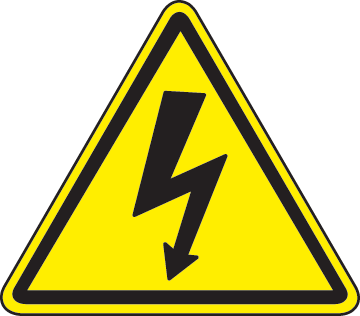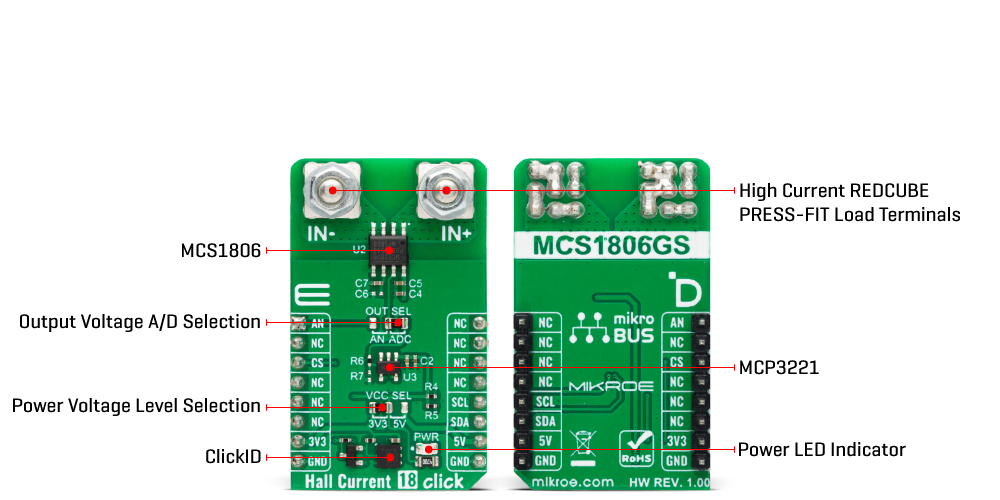OFF
GO LOCAL
| Company | Stock | Price |
|---|---|---|

MIKROE-5832
22 g
Status:
Hall Current 18 Click is a compact add-on board that contains a precise solution for AC/DC current sensing. This board features the MCS1806, an isolated Hall-effect current sensor from MPS. The sensor is immune to external magnetic fields via differential sensing and has no magnetic hysteresis. The MCS1806 features galvanic isolation between the pins of the primary conductive path and the sensor leads, allowing it to replace optoisolators and other isolation devices. This Click board™ makes the perfect solution for the development of multi-phase inverters, motor controls, automotive systems, load detection and management, and more.
Step Down 10 Click is fully compatible with the mikroBUS™ socket and can be used on any host system supporting the mikroBUS™ standard. It comes with the mikroSDK open-source libraries, offering unparalleled flexibility for evaluation and customization. What sets this Click board™ apart is the groundbreaking ClickID feature, enabling your host system to seamlessly and automatically detect and identify this add-on board.
This product is no longer in stock
Availability date:
OFF
| Company | Stock | Price |
|---|---|---|

 DO NOT TOUCH THE BOARD WHILE THE EXTERNAL POWER SUPPLY IS ON!
DO NOT TOUCH THE BOARD WHILE THE EXTERNAL POWER SUPPLY IS ON!
Note: This Click board™ needs to be used by trained personnel only while applying high voltages. Special care should be taken when working with hazardous voltage levels.
Hall Current 18 Click is based on the MCS1806, an isolated Hall-effect current sensor from MPS. Its primary conductor has low resistance and allows current to flow close to the high-accuracy Hall-effect sensors. The current generates a magnetic field that is sensed at two different points by the integrated Hall-effect transducers. The difference in the magnetic field between those two points is converted into a voltage proportional to the applied current. As a low stable offset, a spinning current technique is used.

The output signal of the MCS1806 can be converted to a digital value using MCP3221, a successive approximation A/D converter with a 12-bit resolution from Microchip using a 2-wire I2C compatible interface, or can be sent directly to an analog pin of the mikroBUS™ socket labeled as AN. Selection can be performed by onboard SMD jumper labeled as OUT SEL, placing it to an appropriate position marked as AN and ADC.
Also, this Click board™ should be connected in series with the load. The current is measured by two onboard terminal connectors, one terminal block for the positive and the other for the negative current input.
This Click board™ can operate with either 3.3V or 5V logic voltage levels selected via the VCC SEL jumper. This way, both 3.3V and 5V capable MCUs can use the communication lines properly. Also, this Click board™ comes equipped with a library containing easy-to-use functions and an example code that can be used as a reference for further development.
Type
Current sensor
Applications
Can be used for the development of multi-phase inverters, motor controls, automotive systems, load detection and management, and more
On-board modules
MCS1806- isolated Hall-effect current sensor from MPS
Key Features
Immune to external magnetic fields via differential sensing, 3KVRMS minimum isolation voltage, good accuracy, adjustable bandwidth, output proportional to AC or DC currents, factory-trimmed accuracy, and more
Interface
I2C
Feature
ClickID
Compatibility
mikroBUS™
Click board size
M (42.9 x 25.4 mm)
Input Voltage
3.3V or 5V
This table shows how the pinout on Hall Current 18 Click corresponds to the pinout on the mikroBUS™ socket (the latter shown in the two middle columns).
| Label | Name | Default | Description |
|---|---|---|---|
| LD1 | PWR | - | Power LED Indicator |
| JP1 | VCC SEL | Left | Logic Level Voltage Selection 3V3/5V: Left position 3V3, Right position 5V |
| JP2 | OUT SEL | Right | Output Voltage A/D Selection AN/ADC: Left position AN, Right position ADC |
| Description | Min | Typ | Max | Unit |
|---|---|---|---|---|
| Supply Voltage | 3.3 | - | 5 | V |
| Optimized Primary Current Range | -40 | - | +40 | A |
| Typical Sensitivity | - | 33 | - | mV/A |
We provide a library for the Hall Current 18 Click as well as a demo application (example), developed using MIKROE compilers. The demo can run on all the main MIKROE development boards.
Package can be downloaded/installed directly from NECTO Studio Package Manager (recommended), downloaded from our LibStock™ or found on Mikroe github account.
Library Description
This library contains API for Hall Current 18 Click driver.
Key functions
hallcurrent18_read_current Hall Current 18 read current function.
hallcurrent18_read_voltage Hall Current 18 read voltage level function.
hallcurrent18_read_raw_adc Hall Current 18 read raw ADC value function.
Example Description
This example demonstrates the use of Hall Current 18 Click board™ by reading and displaying the current measurements.
void application_task ( void )
{
float current = 0;
if ( HALLCURRENT18_OK == hallcurrent18_read_current ( &hallcurrent18, ¤t ) )
{
log_printf( &logger, " Current : %.2f [A]rnn", current );
Delay_ms( 1000 );
}
}
The full application code, and ready to use projects can be installed directly from NECTO Studio Package Manager (recommended), downloaded from our LibStock™ or found on Mikroe github account.
Other Mikroe Libraries used in the example:
Additional notes and informations
Depending on the development board you are using, you may need USB UART click, USB UART 2 Click or RS232 Click to connect to your PC, for development systems with no UART to USB interface available on the board. UART terminal is available in all MIKROE compilers.
This Click board™ is supported with mikroSDK - MIKROE Software Development Kit. To ensure proper operation of mikroSDK compliant Click board™ demo applications, mikroSDK should be downloaded from the LibStock and installed for the compiler you are using.
For more information about mikroSDK, visit the official page.
NOTE: Please be advised that any peripheral devices or accessories shown connected to the Click board™ are not included in the package. Check their availability in our shop or in the YMAN section below.